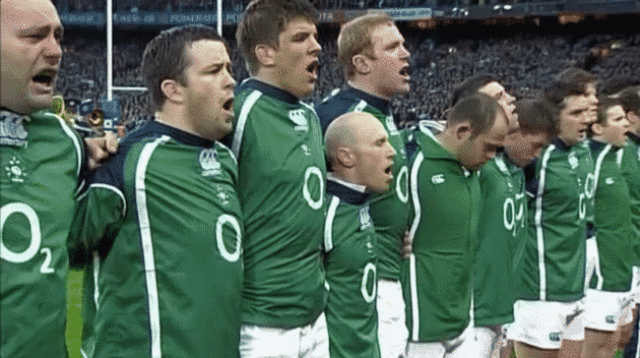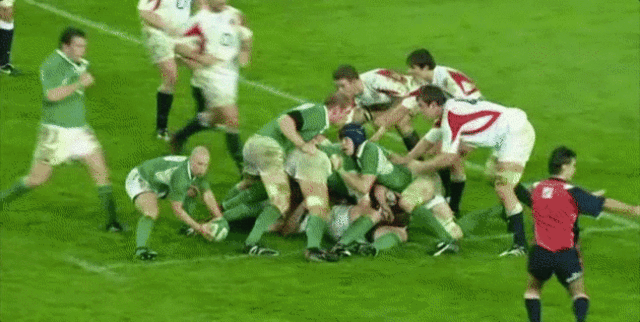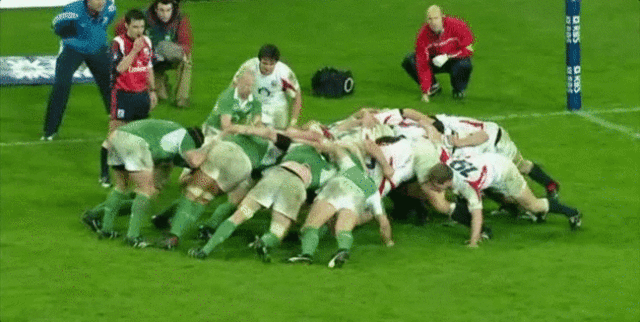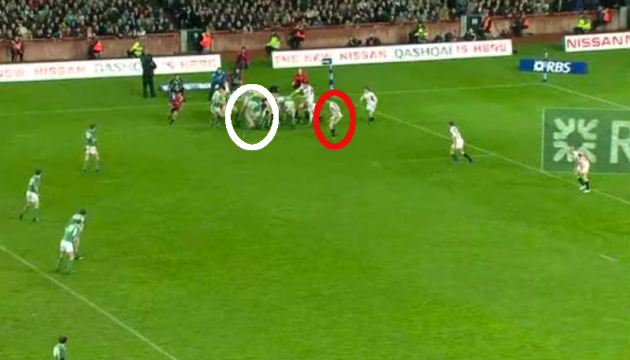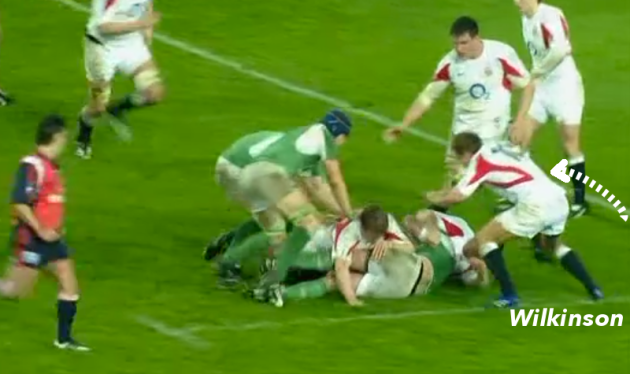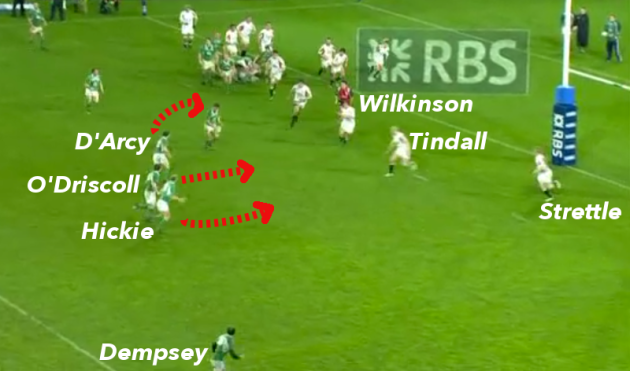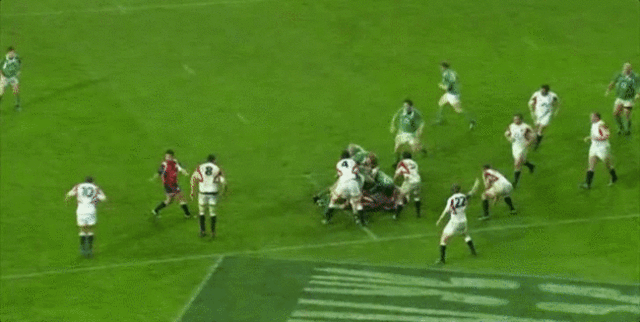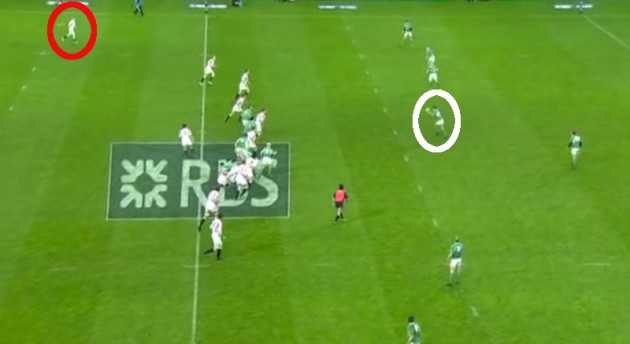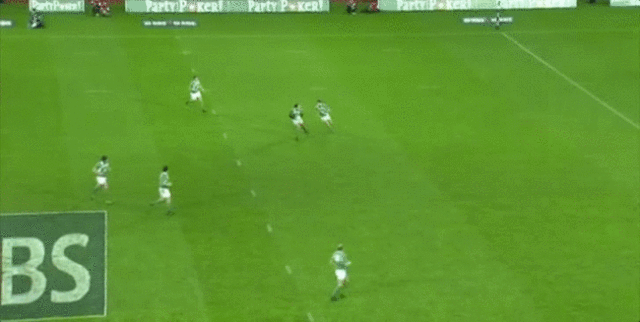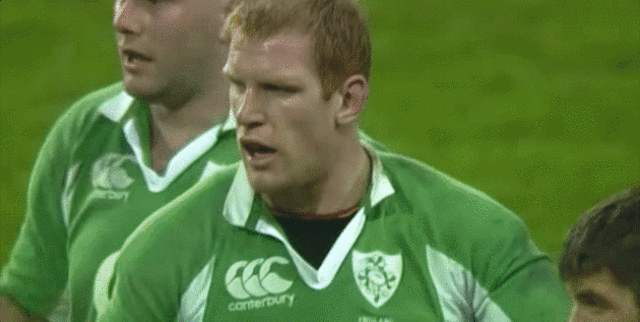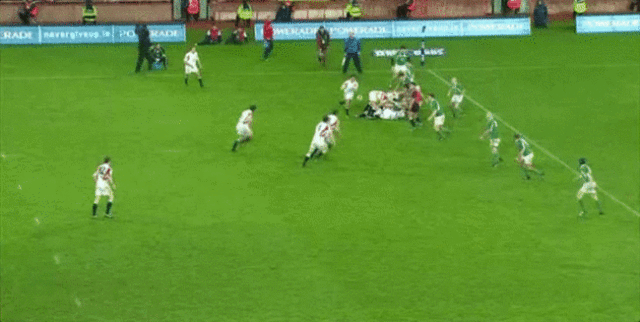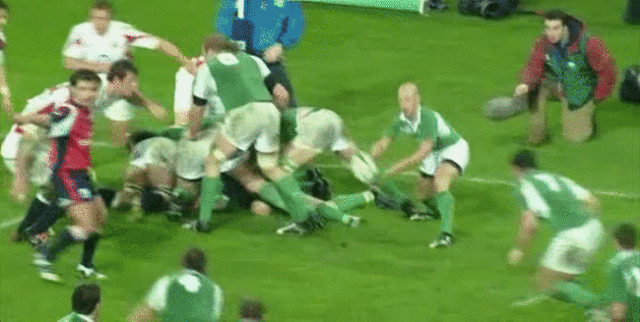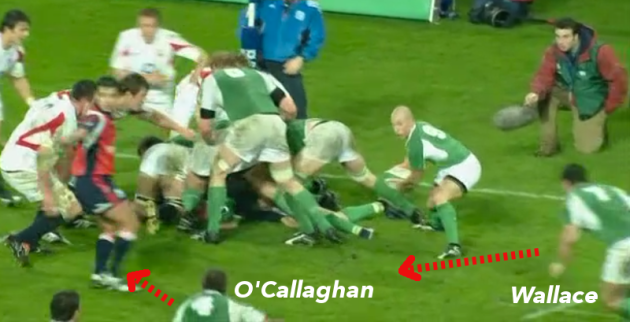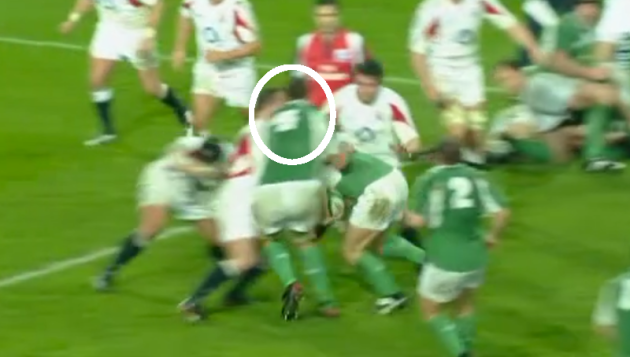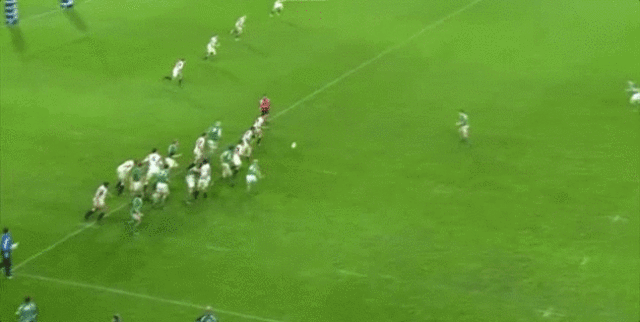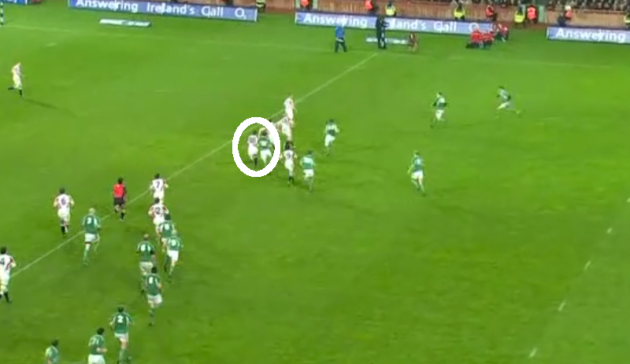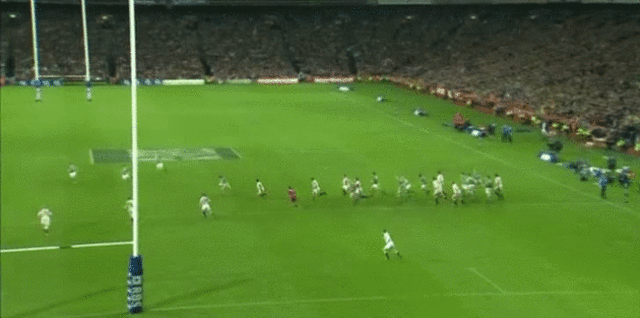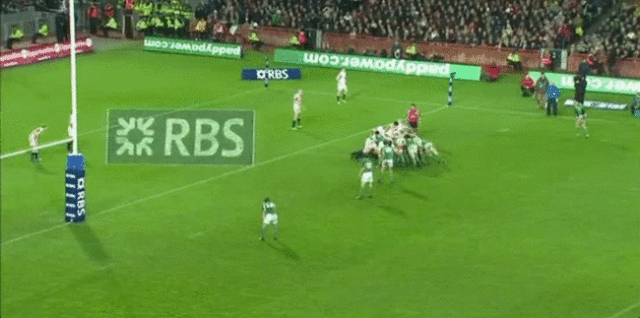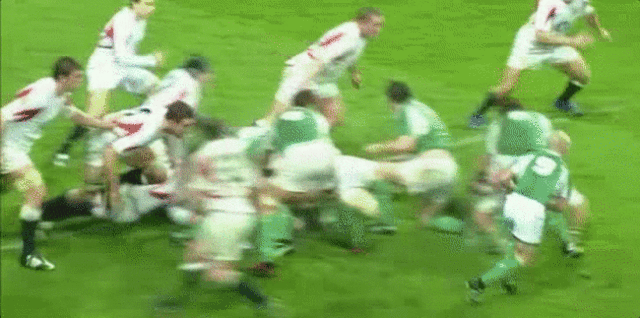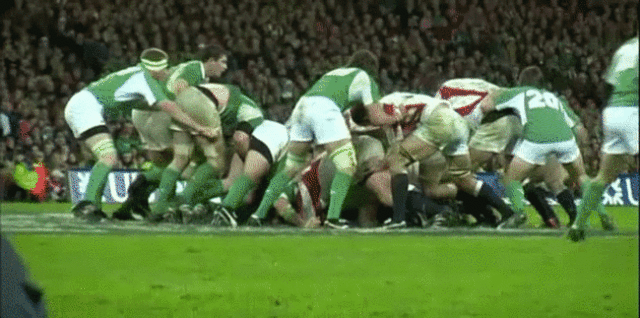Click here for more of The42′s Ireland v England anniversary series >
THERE ARE MANY iconic images from before, during and after Ireland’s unforgettable victory over England at Croke Park in 2007.
John Hayes shedding tears during the national anthem is certainly somewhere towards the top of the list.
This shot of Hayes’ emotions bursting to the surface will stir feelings in many Ireland fans even now, and it illustrates exactly how aware Eddie O’Sullivan’s team were of the historic circumstances of the game.
What was perhaps most remarkable about the Irish performance in their 43-13 victory over the English was how they managed to channel those emotions in a clinical, tactically-astute manner.
Every rugby team needs emotional drivers to underpin their actions on the pitch, but there is a fine balance here. Slipping into an over-emotional and error-strewn display is easy in these kind of exceptional circumstances, but Ireland were controlled.
Fiery, aggressive and confrontational, with the right hint of viciousness, but calm enough to deliver on head coach Eddie O’Sullivan’s key coaching messages.
The result was a superb performance on one of the most important days in the history of rugby in Ireland.
Shaggy’s classic
The symbol of this victory was the superb second-half try scored by right wing Shane Horgan, who fittingly rose into the Croke Park sky and plucked the ball out of the air with a GAA-esque overhead catch.
The assisting kick from Ronan O’Gara was similarly reminiscent of some of the stunning football the Dublin venue has seen played over the years. This try won’t be forgotten any time soon.
The skill level from Ireland is eye-opening here, that ability to focus and carry out what are basics of the sport even in an emotional and high-pressure situation.
O’Gara’s kick is perfection, beautifully weighted to allow Horgan to run onto the ball and rise over Josh Lewsey to claim. The Ireland out-half’s judgement of the depth required on his kick is all the more impressive given the ‘empty’ pitch space beyond the deadball line in Croke Park.
But to fully understand the beauty of this try from Ireland, we must go back to the first phase of this cleverly-planned attack.
Superb handling down the left touchline from Brian O’Driscoll, Denis Hickie and Horgan has resulted in O’Driscoll being held up over the English tryline, so Ireland have the feed to the five-metre scrum.
John Hayes’ right knee goes to ground, but referee Joël Jutge is happy for Ireland to play off the scrum, and the speed of the ball catches England’s back row off guard.
These were still the days when the backline defence didn’t have to be five metres back from the scrum, so when Denis Leamy picks and goes from the base of the set-piece, he doesn’t have quite as much room as a number eight would in today’s game.
England’s system at the time involved inside centre Andy Farrell [red circle below] defending as the first man out from the scrum, so Leamy [white] is carrying directly into Farrell as he gets outside the English back row.
Leamy dominates the collision to get Ireland right over the gainline, and takes Farrell to deck with him – a crucial part of the plan.
We can also see that the impact and threat of Leamy’s carry briefly draws Jonny Wilkinson in towards the ball.
Wilkinson stops short of jackaling over the ball, but already Leamy’s carry has had exactly the effect Ireland have planned for. The English defensive line has been narrowed up and space has been created wide on the right.
Horgan has maintained his width throughout the passage of attack and with England’s defensive line now short one back, they are narrower than they would like to be in this situation.
Accentuating England’s problem is the midfield threat from Ireland.
We can see above that left wing Hickie has joined O’Driscoll and Gordon D’Arcy in the middle of the pitch, and that trio run lines around O’Gara to interest the English defence.
The image above shows that England left wing David Strettle is, therefore, lured in tight in the defensive line and there is clear space for O’Gara to kick into, with Dempsey and Horgan waiting in the wings.
Lewsey, wearing 14 but now playing fullback, is sweeping across to cover the possible kick option but he is left in an unenviable position as he sprints to make up the ground and realistically has no chance against a player of Horgan’s height and aerial ability.
The Leinster man brilliantly fields the ball overhead with technique that is still not in the armoury of some international wings in the current game.
It couldn’t have been scripted any better, but the point is that this iconic moment in Irish rugby history was indeed scripted and then stunningly executed in the heat of the moment.
Kicking class
O’Gara’s sublime kick for Horgan’s try wasn’t the only lovely touch the Munster man had with the boot on that famous day at Croker.
While the out-half’s passing game was perhaps underrated – he had several beauties in this game – it was no surprise that ROG’s kicking ability played a prominent part in the contest against England.
Ireland went into half-time leading 23-3 and a large part of their success in the opening 40 minutes was down to the clever tactical kicking led by O’Gara.
We see one of his classic spirals to touch in the instance above, a skill that is increasingly absent in the game today. The sheer length O’Gara can get on the kick, while still keeping it low to the ground, is extremely impressive.
In this case, O’Gara [white circle above] identifies space in behind the inexperienced Strettle [red] and doesn’t hesitate for a second, firing the ball deep into the backfield and kicking with enough power to ensure that covering fullback Olly Morgan is not going to benefit from the ball bouncing up.
O’Gara’s deeply-practiced ability to find grass with his tactical kicking was essential for Ireland as they looked to ensure the game was played in England’s defensive territory.
With the Irish pack delivering a hugely muscular performance and posing a threat to the English lineout throw, Ireland’s kicking tactics were intelligent.
Having a man like O’Gara to calmly and accurately deliver on the plan was also essential.
Fronting up
The Irish pack was wonderfully led by a hungry Paul O’Connell, who was a mammoth at lineout time in particular.
The Munster lock was the primary target for Rory Best and also manage to cause havoc on George Chuter’s throw.
O’Connell’s performance was full of the kind of manic aggression he demanded from others – his big hit on Martin Corry from one restart was a highlight – but he combined that with intelligent focus.
Ireland’s success at the lineout, coached by Niall O’Donovan at that time, was a cornerstone of the success at Croker, and O’Connell’s ability to read the set-piece was important. The steal we see above was typical of his understanding.
Physically, Ireland were superior to the English pack too.
We get an illustration of that in the incident below, as Ireland pull off a choke tackle turnover – some time before Les Kiss arrived and was credited with its design.
Here, we see several of the key influencers of the day in action.
Props John Hayes and Marcus Horan initiate the tackle, part of a front row display that saw the Munster duo win scrum penalties and clear rucks tirelessly. Hooker Rory Best is next in to join his front row mates.
The abrasive and skillful Simon Easterby hammers into the contest, while the powerful Leamy is also present as Ireland hold Corry off the ground. Nearby and communicating are second row pair O’Connell and Donncha O’Callaghan. A cohesive pack effort.
While openside David Wallace is not involved here, he was an integral part of the Irish victory.
His close-range try was a ‘Wally’ special, as his incredible leg drive took him through contact to score.
Scrum-half Peter Stringer feeds Wallace in this instance, and his explosive power drives him right through Chuter and England loosehead Perry Freshwater.
Wallace’s physical prowess is crucial, but he also benefits from the running line of O’Callaghan to his left.
O’Callaghan’s run adds another slight distraction for Chuter and the England defence, as he thunders onto a possible pass from Stringer.
The Ireland nine opts for Wallace instead and we can see that O’Callaghan causes further stress by actually getting in between tackler Chuter and ball carrier Wallace.
Chuter makes contact with both O’Callaghan and Wallace as he looks to tackle the latter, with the Ireland second row’s presence just reducing the effectiveness of his first contact.
While O’Callaghan could be pinged for obstruction here, of course, there is just enough subtlety to it not to fully attract Jutge’s attention as he thinks about a possible grounding for the try.
Wallace’s pure determination sees him stretch out his left arm to find the tryline and send Ireland into the break with a commanding 23-3 advantage and ‘The Fields of Athenry’ ringing around Croke Park.
Eddie’s touch
That Ireland found themselves in the try-scoring position above was down to their clever set-piece attack, with this particular example seeing O’Sullivan’s men targeting Farrell at inside centre.
It’s an excellent set-piece strike, with Stringer getting Ireland rolling with a stunningly rapid pass to O’Gara, in front of the out-half and inviting him to run at England.
O’Gara echoes his scrum-half by launching an excellent left-handed skip pass to O’Driscoll and then the outside centre bursts diagonally to his right with fullback Dempsey, before right wing Horgan appears on a late, late switch line.
D’Arcy is the man skipped by O’Gara, but he has an important part to play here. As we can see below, the Ireland 12 gets a slight nudge on Wilkinson, knocking him out of the drift.
The English defence is completely flummoxed by Ireland’s move – which appears to be specifically designed to pick on rugby league convert Farrell, starting in just his third union Test match.
While the current Ireland defence coach was excellent in contact and thrived when players ran in straight lines at him, the difficulty in converting to union was in picking up attackers changing their running lines late and close to the defensive line.
Farrell over-drifts in this instance, as he tracks O’Driscoll’s diagonal run across the pitch and fails to identify Horgan changing the angle on a clever switch line.
The reverse angle above shows us how O’Driscoll’s movement drags Farrell into shifting all the way across the pitch, actually ending up underneath outside centre Mike Tindall, and leaving the space on his inside for Horgan to burst into.
Chasing Farrell across the pitch, Wilkinson is similarly caught on the inside shoulder – although this is where D’Arcy’s nudge becomes important, as the England out-half is unable to react from a position slightly further down the pitch that he would have been without D’Arcy’s intervention.
Essentially, Ireland’s backline move lures five English defenders – Wilkinson, Farrell, Tindall, Strettle and fullback Lewsey – into covering two Irish attackers in O’Driscoll and Dempsey.
Horgan breaches the line and only an excellent covering tackle from Mathew Tait halts him, before O’Connell knocks-on on the very next phase.
An England feed to the scrum, but how do Ireland react?
Hayes, Horan and co. fire up their drive to pressure the English pack yet again, and then Stringer and Wallace manhandle Corry over the English tryline to force the turnover.
The passion and the clinical edge combining once again.
It’s worth noting that England’s midfield was exploited by Ireland throughout this game, not just with the starter play above.
Dempsey’s first-half try also saw a mix-up in the English centres, as a beautiful moment of skill from D’Arcy allowed Ireland to score wide on the right.
Clearly, it’s the flicked pass by D’Arcy from the bouncing ball that stands out here, but we must note the alignment of the English defence too.
As the ball bounces beyond O’Gara in the image below, we can see that both Tindall and Farrell are lined up on the Ireland out-half.
Tindall ought to be worrying about D’Arcy and Hickie in this instance, but he doesn’t appear to trust that Farrell will deal with O’Gara himself and makes a poor decision to bite in.
So, instead of advancing up and out towards D’Arcy and Hickie [red below], Tindall comes up and in on O’Gara [yellow].
That means two English defenders are committed to O’Gara and when D’Arcy wonderfully flicks the ball out to O’Driscoll, there is absolutely no hope of Brian Ashton’s men preventing the try.
While that score would have hurt England, there was even more self-imposed damage to come in a game where they looked completely beaten by the occasion.
Ireland replacement scrum-half Isaac Boss intercepted opposite number number Shaun Perry’s attempted switch pass off a scrum in the final minute to rub salt in the wounds.
The confusion in the English ranks here was typical on a day where Ireland’s controlled and clincial emotion drove them to one of the great wins in Irish rugby history.
IRELAND: Girvan Dempsey; Shane Horgan, Brian O’Driscoll (captain), Gordon D’Arcy, Denis Hickie; Ronan O’Gara, Peter Stringer; Marcus Horan, Rory Best, John Hayes; Donncha O’Callaghan, Paul O’Connell; Simon Easterby, David Wallace, Denis Leamy.
Replacements: Jerry Flannery, Simon Best, Mick O’Driscoll, Neil Best, Isaac Boss, Paddy Wallace, Andrew Trimble.
ENGLAND: Olly Morgan; Josh Lewsey, Mike Tindall, Andy Farrell, David Strettle; Jonny Wilkinson, Harry Ellis; Perry Freshwater, George Chuter, Phil Vickery (captain); Louis Deacon, Danny Grewcock; Joe Worsley, Magnus Lund, Martin Corry.
Replacements: Lee Mears, Julian White, Tom Palmer, Tom Rees, Shaun Perry, Toby Flood, Mathew Tait.
Subscribe to The42 Rugby Show podcast here:
